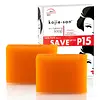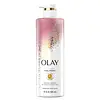What's inside
What's inside
 Key Ingredients
Key Ingredients

 Benefits
Benefits

 Concerns
Concerns

 Ingredients Side-by-side
Ingredients Side-by-side

Cocos Nucifera Oil
MaskingWater
Skin ConditioningSodium Hydroxide
BufferingParfum
MaskingKojic Acid
AntioxidantGlycerin
HumectantXanthan Gum
EmulsifyingCaprylyl Glycol
EmollientGlucose
HumectantChondrus Crispus
MaskingPhenoxyethanol
PreservativeEthylhexylglycerin
Skin ConditioningCocamide DEA
EmulsifyingParaffinum Liquidum
EmollientMelaleuca Alternifolia Leaf Oil
AntioxidantCI 15985
Cosmetic ColorantCI 19140
Cosmetic ColorantBHT
AntioxidantWater
Skin ConditioningPetrolatum
EmollientSodium Trideceth Sulfate
CleansingSodium Chloride
MaskingCocamidopropyl Betaine
CleansingParfum
MaskingTrideceth-3
EmulsifyingNiacinamide
SmoothingSodium Hyaluronate
HumectantGuar Hydroxypropyltrimonium Chloride
Skin ConditioningSodium Benzoate
MaskingXanthan Gum
EmulsifyingGlyceryl Oleate
EmollientCitric Acid
BufferingSodium Hydroxide
BufferingDisodium EDTA
Acrylates/C10-30 Alkyl Acrylate Crosspolymer
Emulsion StabilisingButyrospermum Parkii Butter
Skin ConditioningMethylchloroisothiazolinone
PreservativeMethylisothiazolinone
PreservativeCI 19140
Cosmetic ColorantCI 17200
Cosmetic ColorantWater, Petrolatum, Sodium Trideceth Sulfate, Sodium Chloride, Cocamidopropyl Betaine, Parfum, Trideceth-3, Niacinamide, Sodium Hyaluronate, Guar Hydroxypropyltrimonium Chloride, Sodium Benzoate, Xanthan Gum, Glyceryl Oleate, Citric Acid, Sodium Hydroxide, Disodium EDTA, Acrylates/C10-30 Alkyl Acrylate Crosspolymer, Butyrospermum Parkii Butter, Methylchloroisothiazolinone, Methylisothiazolinone, CI 19140, CI 17200
 Reviews
Reviews

Ingredients Explained
These ingredients are found in both products.
Ingredients higher up in an ingredient list are typically present in a larger amount.
CI 19140 is also known as Tartrazine. Tartrazine is a synthetic dye used in cosmetics, foods, and medicine to add a yellow color.
Tartrazine is created from petroleum and is water-soluble.
Some people may experience allergies from this dye, especially asthmatics and those with an aspirin intolerance.
Learn more about CI 19140Parfum is a catch-all term for an ingredient or more that is used to give a scent to products.
Also called "fragrance", this ingredient can be a blend of hundreds of chemicals or plant oils. This means every product with "fragrance" or "parfum" in the ingredients list is a different mixture.
For instance, Habanolide is a proprietary trade name for a specific aroma chemical. When used as a fragrance ingredient in cosmetics, most aroma chemicals fall under the broad labeling category of “FRAGRANCE” or “PARFUM” according to EU and US regulations.
The term 'parfum' or 'fragrance' is not regulated in many countries. In many cases, it is up to the brand to define this term.
For instance, many brands choose to label themselves as "fragrance-free" because they are not using synthetic fragrances. However, their products may still contain ingredients such as essential oils that are considered a fragrance by INCI standards.
One example is Calendula flower extract. Calendula is an essential oil that still imparts a scent or 'fragrance'.
Depending on the blend, the ingredients in the mixture can cause allergies and sensitivities on the skin. Some ingredients that are known EU allergens include linalool and citronellol.
Parfum can also be used to mask or cover an unpleasant scent.
The bottom line is: not all fragrances/parfum/ingredients are created equally. If you are worried about fragrances, we recommend taking a closer look at an ingredient. And of course, we always recommend speaking with a professional.
Learn more about ParfumSodium Hydroxide is also known as lye or caustic soda. It is used to adjust the pH of products; many ingredients require a specific pH to be effective.
In small amounts, sodium hydroxide is considered safe to use. However, large amounts may cause chemical burns due to its high alkaline.
Your skin has a natural pH and acid mantle. This acid mantle helps prevent harmful bacteria from breaking through. The acid mantle also helps keep your skin hydrated.
"Alkaline" refers to a high pH level. A low pH level would be considered acidic.
Learn more about Sodium HydroxideWater. It's the most common cosmetic ingredient of all. You'll usually see it at the top of ingredient lists, meaning that it makes up the largest part of the product.
So why is it so popular? Water most often acts as a solvent - this means that it helps dissolve other ingredients into the formulation.
You'll also recognize water as that liquid we all need to stay alive. If you see this, drink a glass of water. Stay hydrated!
Learn more about WaterXanthan gum is used as a stabilizer and thickener within cosmetic products. It helps give products a sticky, thick feeling - preventing them from being too runny.
On the technical side of things, xanthan gum is a polysaccharide - a combination consisting of multiple sugar molecules bonded together.
Xanthan gum is a pretty common and great ingredient. It is a natural, non-toxic, non-irritating ingredient that is also commonly used in food products.
Learn more about Xanthan Gum